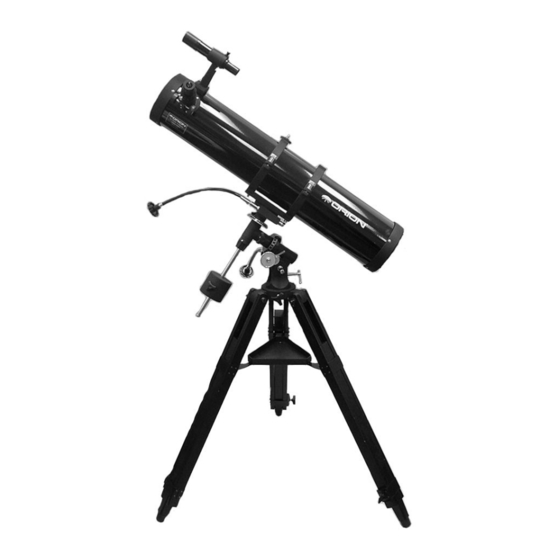Table of Contents
Advertisement
Quick Links
Download this manual
See also:
Instruction Manual
Advertisement
Table of Contents

Summary of Contents for ORION TELESCOPES & BINOCULARS SpaceProbe 130mm EQ 9027
- Page 1 INSTRUCTION MANUAL Orion ® SpaceProbe 130mm EQ Equatorial Newtonian Reflector Telescope #9027 Customer Support (800) 676-1343 E-mail: support@telescope.com Corporate Offices (831) 763-7000 P.O. Box 1815, Santa Cruz, CA 95061 Providing Exceptional Consumer Optical Products Since 1975...
- Page 2 Alignment thumb screws(2) Finder scope Spring -loaded Dovetail slot tensioner Finder scope bracket Eyepiece Piggyback adapter Tube mounting rings Focuser Dec. slow-motion control cable Tube ring clamps Primary mirror cell Dec. setting circle R.A. lock knob Collimation screws(6) Counterweight Counterweight R.A.
-
Page 3: Table Of Contents
ongratulations on your purchase of a quality Orion telescope . Your new SpaceProbe 130mm EQ is designed for high-resolution viewing of astronomical objects. With its precision optics and equatorial mount, you’ll be able to locate and enjoy hundreds of fascinating celestial denizens, including the plan- ets, Moon, and a variety of deep-sky galaxies, nebulas, and star clusters. -
Page 4: Assembly
3. Assembly the other hand. When it is threaded as far in as it will go, position the counterweight about halfway up the shaft and tighten the counterweight lock knob. The retaining screw Assembling the telescope for the first time should take about and washer on the bottom of the shaft prevent the coun- 30 minutes. -
Page 5: Getting Started
Figure 3A, 3B, 3C, 3D. Proper operation of the equatorial mount requires that the telescope tube be balanced on both the R.A. and Dec. axes. (a) With the R.A. lock knob released, slide the counterweight along the counterweight shaft until it just counterbalances the tube. (b) When you let go with both hands, the tube should not drift up or down. - Page 6 3. Retighten the counterweight lock knob. The telescope is retighten the R.A. and Dec. lock knobs. Use the slow-motion now balanced on the R.A. axis. control cables to center the object in the eyepiece. 4. To balance the telescope on the Dec. axis, first tighten the Now, look in the finder scope.
-
Page 7: Setting Up And Using The Equatorial Mount
Focusing the Finder Scope first the R.A. axis of the mount must be aligned with the Earth’s rotational (polar) axis - a process called polar alignment. If, when looking through the finder scope, the images appear somewhat out of focus, you will need to refocus the Polar Alignment finder scope for your eyes. - Page 8 Note : From this point on in your observing session, you remain stationary in the field of view without any manual should not make any further adjustments in the azimuth adjustment of the R.A. slow-motion control. or the latitude of the mount, nor should you move the tri- Understanding the Setting Circles pod.
- Page 9 Figure 7. This illustration shows the telescope pointed in the four cardinal directions: (a) north, (b) south, (c) east, (d) west. Note that the tripod and mount have not been moved; only the telescope tube has been moved on the R.A. and Dec. axes. 1.
-
Page 10: Collimating The Optics
Similarly, to point the telescope directly south, the counter- 6. Collimating the Optics weight shaft should again be horizontal. Then you simply rotate (Aligning the Mirrors) the scope on the Dec. axis until it points in the south direction. What if you need to aim the telescope directly north, but at Collimation is the process of adjusting the mirrors so they are an object that is nearer to the horizon than Polaris? You can’t precisely aligned with each other. - Page 11 it is very helpful to use a precision collimating tool containing crosshairs, such as the Orion Collimating Eyepiece (#3640). We highly recommend that you purchase one. Aligning the Secondary Mirror With the eyepiece removed, look straight down the open focuser drawtube at the secondary (diagonal) mirror. Ignore the reflections for the time being.
-
Page 12: Using Your Telescope-Astronomical Observing
have two people for primary mirror collimation, one to look in through an open (or closed) window, because the tempera- the focuser while the other adjusts the collimation screws.) ture difference between the indoor and outdoor air will cause image blurring and distortion. The view down the focuser should now resemble Figure 8a. - Page 13 divide the focal length of the telescope by the focal length of Objects to Observe the eyepiece: Now that you are all set up and ready to go, one critical deci- sion must be made: what to look at? Telescope focal length = Magnification A.
- Page 14 each side of Saturn’s disk. A steady atmosphere (good see- Start by choosing bright objects to view. The brightness of an ing) is necessary for a good view. You will probably see a object is measured by its visual magnitude; the brighter an bright “star”...
-
Page 15: Astrophotography
the stars you are centering in the eyepiece. Remember, the the illuminated reticle eyepiece into the telescope’s star diago- finder scope (and main telescope eyepiece, for that matter) nal. Turn the eyepiece’s illuminator on (dimly!). Re-center the gives an inverted image, so you must keep this in mind when bright star (guide star) on the crosshairs of the reticle eyepiece. -
Page 16: Specifications
Cleaning Lenses ing detergent, and if possible, a cap-full of rubbing alcohol. Submerge the mirror (aluminized face up) in the water and let Any quality optical lens cleaning tissue and optical lens clean- it soak for several minutes (or hours if it’s a very dirty mirror). ing fluid specifically designed for multi-coated optics can be Wipe the mirror under water with clean cotton balls, using used to clean the exposed lenses of your eyepieces or finder...
















Need help?
Do you have a question about the SpaceProbe 130mm EQ 9027 and is the answer not in the manual?
Questions and answers